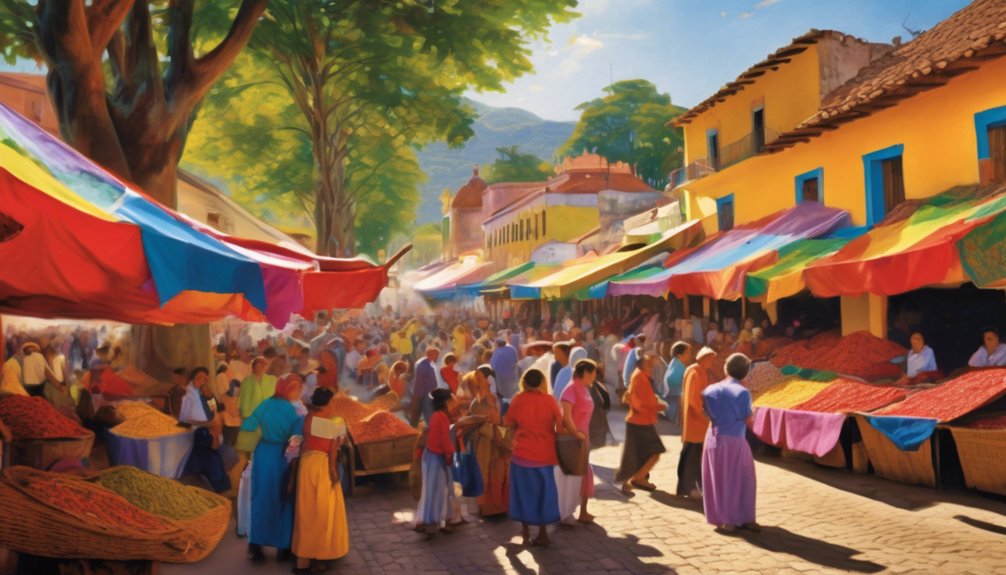
You’ve likely noticed that Spanish and Portuguese dominate the linguistic landscape of Latin America. This prevalence isn’t just a coincidence; it stems from complex historical and economic factors. As you explore this topic, consider how colonialism shaped language use and the ongoing influence of trade and media. What happens to the region’s rich tapestry of indigenous languages in this situation? The answers might surprise you.
Key Takeaways
- Colonialism established Spanish and Portuguese as dominant languages in Latin America, marginalizing indigenous languages.
- Trade agreements favor Spanish and Portuguese, reinforcing their use in business and communication.
- Education systems prioritize Spanish and Portuguese, limiting the recognition and support for indigenous languages.
- Globalization and cultural assimilation contribute to the decline of indigenous languages, overshadowing local linguistic diversity.
- Media and technology predominantly feature Spanish and Portuguese content, influencing language preferences and learning trends across the region.
The Legacy of Colonialism
Although colonialism ended centuries ago, its impact on language in Latin America is still evident today. You can see how colonial history shaped the linguistic landscape, creating a scenario where Spanish and Portuguese emerged as dominant languages. The colonial powers imposed their languages on indigenous populations, leading to a significant shift in communication and cultural expression. This linguistic dominance often marginalized native languages, many of which are now endangered or lost. As you explore the region, you’ll notice that the remnants of this colonial legacy affect not just language, but also identity and social dynamics. Understanding this history helps you appreciate the rich tapestry of languages and cultures that still coexist in Latin America today.
The Role of Trade and Economic Influence
The influence of trade and economic interactions has further shaped the linguistic landscape of Latin America. As countries engage in trade agreements and pursue economic integration, dominant languages like Spanish and Portuguese gain prominence. You’ll notice that businesses often adopt these languages for effective communication, influencing how people interact in both professional and social settings. This economic focus can overshadow local languages, leading to a more homogeneous linguistic environment. Additionally, as multinational companies establish operations, they bring their language and culture, reinforcing the dominance of Spanish and Portuguese. Consequently, the intertwining of trade and language not only reflects economic priorities but also shapes cultural identities, making it vital for you to understand these dynamics when exploring Latin America’s rich linguistic heritage.
Indigenous Languages and Their Impact
While many people associate Latin America primarily with Spanish and Portuguese, the region is home to a rich tapestry of indigenous languages that profoundly impact cultural identity and social dynamics. These languages, like Quechua and Nahuatl, are not just means of communication; they’re essential components of cultural heritage. You might notice how efforts in indigenous revitalization are gaining momentum, empowering communities to reconnect with their roots. By embracing their languages, individuals foster a stronger sense of identity and pride. As these languages thrive, they influence art, music, and traditions, enriching the broader cultural landscape. Understanding this linguistic diversity deepens your appreciation for Latin America’s unique traditions and histories, reminding you that there’s so much more than just Spanish and Portuguese.
Language Policy and Education Systems
When you consider language policy in Latin America, you see how it shapes education systems across the region. Official language policies can either support or hinder the inclusion of indigenous languages in schools. It’s vital to understand how these policies impact students’ learning experiences and cultural identity.
Official Language Policies
In many Latin American countries, official language policies play a crucial role in shaping education systems and cultural identity. These policies often focus on official language enforcement, promoting Spanish and Portuguese while sidelining indigenous languages. This approach can lead to significant bilingualism challenges, as many communities struggle to preserve their native tongues. You might notice that education systems prioritize teaching in the dominant languages, which can alienate students who speak minority languages at home. Consequently, you may find that these policies not only impact language learning but also affect students’ self-esteem and cultural connection. By understanding the implications of official language policies, you can better appreciate the complexities of language dynamics in Latin America.
Education System Influence
Language policies in education systems considerably shape how students engage with both their native tongues and the dominant languages of their countries. In many Latin American countries, the emphasis on a single language in the language curriculum often sidelines indigenous languages, limiting bilingual education opportunities. This focus can lead to:
- Reduced proficiency in native languages
- Increased cultural erosion
- Limited engagement with diverse communities
- A reliance on standardized testing that favors dominant languages
The Influence of Media and Technology
As media and technology evolve, they play an essential role in shaping linguistic dynamics across Latin America. With increased technology access, you’re exposed to diverse media consumption habits that influence language use. Social media platforms, streaming services, and online news outlets primarily feature Spanish and Portuguese content, reinforcing their dominance. You might notice that popular trends, memes, and slang often spread rapidly through these mediums, further solidifying these languages. Additionally, the rise of digital content in these two languages means non-native speakers are often encouraged to learn them for better engagement. This creates a feedback loop where media shapes language preferences, making it challenging for lesser-spoken languages to thrive in the same environment. Ultimately, technology and media directly impact language dynamics in your daily life.
Cultural Identity and Language Preservation
While many people associate language solely with communication, it serves as an important thread connecting individuals to their cultural identity. By preserving languages, you help maintain your cultural heritage and guarantee future generations can express their identity. When you engage with your language, you not only honor your ancestors but also strengthen community bonds.
- Language as a vehicle for storytelling
- Unique expressions of traditions and values
- Fostering pride and belonging within communities
- Protecting endangered dialects for future generations
Embracing your language enriches your identity expression, making it crucial for cultural continuity. By valuing and promoting linguistic diversity, you contribute to a vibrant tapestry of cultures in Latin America, ensuring that the unique voices of various communities continue to resonate.
The Future of Languages in Latin America
As you consider the future of languages in Latin America, think about the efforts being made to preserve indigenous languages amid growing globalization. You’ll see how these forces shape communication and cultural identity. It’s essential to explore how communities balance tradition with the modern world.
Language Preservation Efforts
Language preservation efforts in Latin America are gaining momentum, reflecting a growing recognition of the importance of maintaining cultural identity. You’ll find various language revitalization initiatives and community engagement programs actively working to support indigenous languages. These efforts not only aim to revive languages but also foster pride in cultural heritage.
- Workshops and classes for language learning
- Collaboration with local schools to integrate native tongues into curricula
- Creation of digital resources and platforms for language practice
- Community events celebrating linguistic diversity
Impact of Globalization
Globalization profoundly shapes the linguistic landscape in Latin America, influencing how languages interact and evolve. As global communication expands, languages like Spanish and Portuguese dominate, while indigenous languages face challenges. You’ll notice cultural exchange intensifying, leading to hybrid languages and new dialects.
Here’s a brief overview of the impact:
| Aspect | Impact |
|---|---|
| Language Dominance | Spanish and Portuguese thrive |
| Indigenous Languages | Declining due to globalization |
| Cultural Exchange | Increased blending of languages |
| Technology Influence | Rise of English in digital platforms |
| Education Trends | Bilingual programs becoming common |
Ultimately, the future of languages in Latin America hinges on balancing these influences while preserving cultural identities.





